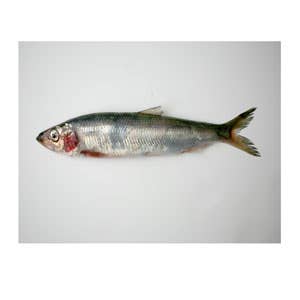
How Fish Get Their Unique Flavor
The circumstances determining the taste of a fish are many and complex. Much depends on whether a fish lives in freshwater or saltwater: saltwater fish counterbalance the salinity of their environment by producing flavor-giving amino acids, including sweet-tasting glycine and savory glutamate, that milder-tasting freshwater fish lack. Fat content is also key, as polyunsaturated fatty acids are vehicles for flavor but are also quick to go rancid, meaning that oily fish must always be well iced to prevent spoilage. The degree of activity of a fish during its lifetime also affects taste: exertion alters muscle structure and, often, increases the level of oxygen-storing (and flavor-giving) pigments. Where and when a fish is caught—the temperature of the water; the types of food in the fish's habitat; whether or not the fish is spawning—influence taste, too. It's also crucial to remember that most fish reach their peak flavor after passing through rigor mortis, which coincides with the buildup of flavor-giving organic compounds in the fish's flesh. So many variables, combined with a paucity of descriptive language, make it hard to ascribe specific flavors to specific species consistently; still, each type of fish could be said to possess a basic flavor profile. Below, we've deconstructed those profiles for ten widely available species and cited the cooking methods that bring out those flavors the best.
1. A wild salmon carries in its DNA (and in its flavor and texture) the imprint of the river it travels during spawning. The genetic strain that swims the 2,000-mile Yukon River in Alaska, for example, must build huge stores of muscle mass and fat in order to survive the trip. Salmon's fatty flesh sears beautifully when grilled or broiled.
2. Cod is a predator that hovers close to the ocean floor and swims very little, so it has hardly any of the strongly flavored red muscle or fat typical of active swimmers. Its mild, white flesh is flaky and delicate and is well suited to sauteing and roasting.
3. If a tuna stops swimming, it suffocates. Its flesh's red color and beefy flavor come from the oxygen-storing pigment myoglobin, which sustains the fish's powerful muscles through a lifetime of nonstop motion. Meaty loin cuts grill nicely, and sushi chefs esteem the fatty belly for its generous marbling and rich flavor.
4. As the herring approaches spawning, its fat content can reach 20 percent, making its flesh deliciously full-flavored when the fish is fresh from the sea, but it may develop a rancid taste and a powerful fishy aroma once its fatty acids begin to oxidize. This volatility makes it a natural for quick-preserving methods like smoking and pickling.
5. Because catfish, like other freshwater fish, hydrate themselves by absorbing water through their skin, wild specimens sometimes taste of the algae or mud present in the water where they're caught. Most catfish in this country are farm-raised in environmentally sustainable, closed-system ponds, so their flesh is consistently sweet and pure tasting. Batter-frying is a popular cooking method.
6. The moniker sea bass is applied to a number of different species, including European sea bass (called loup de mer in France, branzino in Italy) and American striped bass (a k a rockfish). The European sea bass spends its entire life in saltwater, while the striped bass journeys to freshwater to spawn. Sea bass have a dense, firm flesh that is low in fat; the fish may be steamed, sauteed, grilled, or roasted.
7. The freshwater trout available from fishmongers in this country is, almost without exception, farmed rainbow trout grown to single-serving size. Trout is a member of the salmon family, but its flesh lacks the pink coloring and robust flavor that salmon derives from a crustacean-rich diet. The earthy taste of freshwater trout stands up well to strong, savory accompaniments like bacon.
8. Red snapper has sweet, nutty-tasting flesh and tastes wonderful pan-roasted, making it highly sought after. Scarcity due to overfishing has tempted some fishmongers to practice deception: a 2004 University of North Carolina study showed that 75 percent of all fish labeled red snapper in markets is not in fact red snapper but, often, blackfin snapper or Pacific rockfish. To be sure of what you're getting, check the eyes: a real red snapper has bright red irises.
9. The** flatfish** collectively known as American flounder actually belong to a number of different species, including fluke, lemon sole, yellowtail flounder, and gray sole, all cousins of the prized dover sole. Each variety has its distinctive character—gray sole, for instance, has a deep, mineral richness, and winter flounder is reminiscent of shellfish—but all have the subtlety and succulence typical of bottom-hugging flatfish. Sauteeing and steaming are the ideal methods for the delicate, flaky flesh.
10. Dense, meaty** swordfish** (almost always at its best when grilled) has a prominent "blood line"—red muscle tissue, rich in hemoglobin—that appears in swordfish steaks as an area of dark flesh around the backbone. Look for a blood line that is cherry red and taut—indicators of freshness.
Keep Reading
Continue to Next Story










